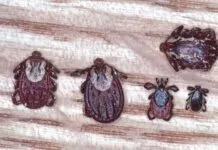[Updated December 14, 2018]
Given the potential duration and magnitude of a Lyme disease infection in your dog, we think it’s pretty important to do something to protect your dog from ticks, especially in areas where cases of Lyme are common. This is one of the instances where you have to weigh all the factors against each other – in this case, your dog’s health and vulnerability, the risk of his exposure to ticks, the prevalence of Lyme in your area, and the tick-repelling and tick-killing products available to you – to decide what you are going to do to protect your dog. It’s not an easy equation; it’s more of a complicated algorithm. Let’s look at each of these areas and how they interact.

Tick-Killing Chemicals and Your Dog’s Immune System
Say your dog is vibrantly healthy – no chronic skin problems, no recurrent ear infections, no mysterious digestive ailments, and no chemical sensitivity that you have noticed. He may not have any problems with an occasional treatment with a pesticide.
Unfortunately, a small percentage of dogs (or people in their families) can’t tolerate the use of powerful insecticides. Some respond with nausea, vomiting, tremors, and even seizures when exposed to even low concentrations of tick-killing chemicals. Others suffer skin reactions: hair loss, rashes, and sores. Animals with compromised organ function or a history of chemical sensitivity may suffer a general health setback after treatment.
Doxycycline
In a study published in the New England Journal of Medicine, researchers at New York Medical College tested the once-controversial strategy of administering a one-time dose of doxycycline immediately after a tick bite, and found that this effectively prevents the development of Lyme disease. The findings have important implications for dogs as well as humans living where Lyme disease is widespread. For those who prefer not to use even a single dose of antibiotics, the swift administration of medicinal herbs and other products that kill bacteria may have a similar result.
The researchers also discovered that Lyme appeared only if a tick had been attached to the skin for 72 hours or longer, verifying the research of Dr. Max Appel. In addition, there was no risk of Lyme if the tick was flat and had not become engorged with blood.
The doxycycline test, led by Dr. Robert Nadelman, was conducted in Westchester County, NY, which has one of the highest rates of Lyme disease in the world.
Your Dog’s Tick Exposure
If you live in an area where there are few or no cases of Lyme disease (among people or dogs), or your dog never has the opportunity to come into contact with ticks (this may be true for many city-dwelling dogs), you may be among the lucky few who don’t have to worry about Lyme disease prevention.
But there are many places where, especially in the tick’s most active time of the year (April through October), any dog that leaves the pavement will end up with ticks. And dogs that spend a lot of time afield will come home loaded with the pests. (The ticks that carry the bacteria that cause Lyme disease include the deer tick and the western black-legged tick; however, other ticks can carry and transmit other diseases, including Rocky Mountain spotted fever, babesiosis, and erlichiosis).
Also, some individual dogs seem to be more attractive to ticks than others. Holistic practitioners often regard an animal’s susceptibility to parasites to be a sign of poor or compromised health – a result of a sputtering immune system or, in more esoteric terms, weak life energy or chi. However, anyone who has been the target of more mosquito bites than his campfire companions might beg to differ; maybe some people (or animals) actually do “taste better.”
Whatever the cause, you might find it necessary to do more to repel ticks from one of your dogs than the others. You may not have to dose each of your pets to the same extent to provide a similar level of protection. Instead, treat each dog as an individual. If you have one dog that tends to attract more ticks, use more repellents (and vigilance) with that dog, and, as long as the ticks stay away from your other dogs, less with them.
Prevalence of Lyme Disease
According to the Centers for Disease Control, in the United States Lyme disease is mostly localized in states in the northeastern, mid-Atlantic, and upper north-central regions, and in several counties in Northern California.
In areas where Lyme is common, the risk is greatest in residential areas surrounded by woods and/or overgrown brush. Venturing off paths and into grassy areas increases a person’s or dog’s exposure to ticks, who sit on grass leaves, waiting for any warm, carbon dioxide-exhaling body to approach. They begin waving their arms as soon as they detect such a candidate and grab ahold!
Tick Repellents and Killers
There are also a number of commercially produced herbal preparations that some owners swear keep ticks off their dogs.
CJ Puotinen, author of The Encyclopedia of Natural Pet Care, says she alternates between a topical repellent made by Heart Foods called Tickweed Plus, and a neem-based repellent called NeemAura Naturals Herbal Outdoor Spray made by NeemAura. Tickweed Plus contains tickweed, neem, pennyroyal, lavender, and other herbs; NeemAura’s product contains neem, myrrh, lemongrass, orange, citronella, and other oils.
Get Puotinen’s recipe for a homemade essential oil tick repellent here.
Comparing Best-Known Pesticide Tick Repellents
| DRUG/ MAKER/ ACTIVE INGREDIENT | APPLICATION | ACTION | FREQUENCY | NOT RECOMMENDED FOR: | PRESCRIPTION? | MODE OF ACTION |
| Adam’s Flea & Tick Mist Farnam Pet Products Pyrethrin |
Liquid spray | Kills and repels ticks | As needed; no more than 1x per week | Puppies less than 12 weeks | No | Pyrethrins are natural extracts of the chrysanthemum plant. They affect the nervous system of insects and kill ticks quickly. Products that contain pyrethrins are generally applied directly to the dog. |
| Bio Spot Farnam Pet Products Permethrin |
Liquid spot application | Kills and repels ticks | Monthly | Puppies less than 12 weeks | No | Permethrin is a synthetic pyrethrin compound that affects the nervous system of insects. In this application, it is used in an oil carrier that helps distribute the chemical over the dog’s body; the permethrin is stored in (and gradually released) from) the animal’s sebaceous (oil-producing) glands. Permethrin lasts longer than natural pyrethrins and is more toxic. |
| Defend Ex Spot Schering-Plough Permethrin |
Liquid spot application | Kills and repels ticks | Monthly | Puppies less than 4 weeks; dogs with known organ dysfunction | No | Permethrin is a synthetic pyrethrin compound that affects the nervous system of insects. In this application, it is used in an oil carrier which helps distribute the chemical over the dog’s body; the permethrin is stored in (and gradually released) from) the animal’s sebaceous (oil-producing) glands. Permethrin lasts longer than natural pyrethrins and is more toxic. |
| Frontline Merial Fipronyl |
Liquid spot application | Kills ticks | Monthly | Puppies less than 12 weeks | Yes | Fipronyl blocks the passage of chlorine through cells in the tick’s nervous system, paralyzing the insect. In this application, fipronyl is mixed with an oil carrier that helps distribute the chemical over the dog’s body; the fipronyl is stored in (and gradually released from) the animal’s sebaceous (oil-producing) glands. |
| Revolution Pfizer Selamectin |
Liquid spot application | Kills American dog ticks only | Monthly | Puppies less than 6 weeks; dogs treated with other topical flea/tick preps; use caution with sick, weak or underweight dogs | Yes | Selamectin blocks the transmission of the insect’s nerve signals; the tick dies of paralysis. Unlike the other liquid, spot-application products, Revolution enters the dog’s bloodstream through the skin, eventually passing into the sebaceous glands and onto the skin and hair. This product is said to control only American dog ticks — NOT the deer ticks that commonly carry Lyme disease. |
| Preventic Collar Virbac, Inc. Amitraz |
Chemically impregnated collar | Kills ticks | 4 months | Puppies less than 12 weeks | No | Amitraz-laden collars kill ticks by inhibiting the function of their nervous system; ticks are paralyzed and die before or shortly after attaching to dog. Amitraz has little or no affect on fleas. May be used in conjunction with other flea and/or tick treatments. |
Dietary Supplements as Tick Repellent
Some holistic practitioners say that adding bitter herbs to a dog’s diet can actually make him less attractive to ticks. Juliette de Bairacli Levy, author of The Complete Herbal Handbook for the Dog and Cat, developed a supplement for this purpose that is now manufactured by Natural Rearing; the herbal antiseptic tablets contain garlic, rue, sage, thyme, eucalyptus, and wormwood.
While neem is most frequently seen as a topical agent used as an insect repellent, first-aid therapy, and to treat a variety of health problems, neem also improves digestion and helps make animals less attractive to fleas, ticks, mosquitoes, and intestinal parasites. Puotinen recommends giving dogs one 500-mg. capsule per 10 pounds of body weight daily.
Beverly Cappel, DVM, of Chestnut Ridge, New York (heart of Lyme country), makes a nutritional supplement called Fleas Flee that contains brewer’s yeast, liver, and oyster shells. Dr. Cappel regards the supplement as very helpful for making dogs less attractive to fleas and ticks, but reminds clients that a supplement should not be regarded as a sole line of protection. (Fleas Flee can be purchased from Dr. Cappel by calling 845-356-3838.)
Thorough and Frequent Tick Checks
The war on ticks can’t take place on just one front; you have to devote time and constant vigilance to prevent sneak attacks on your dog. Practice these anti-enemy missions on a regular basis:
• Check for ticks during and after every outdoor venture. Especially examine your dog’s legs, armpits, belly, neck, and face. Ticks naturally travel toward dark and/or warm, blood-rich areas of the dog. Remember: The goal is to find the ticks when they are still tiny, before they are engorged with blood. The transmission of the Lyme-causing spirochete does not happen until 24 hours after the tick begins feeding.
• Take extra time to examine your dog for the presence of ticks when the pests are at their most active. Ticks increase their movements in mid-morning, from about 8am until about 11am; the largest number of ticks emerge on sunny days. Ticks are also most active from April through October.
• Using a flea comb helps detect and remove tiny ticks. Drop the ticks you find into a container of tick-killing solution. Do not squish them or toss them away; the tiny creatures can survive this treatment.









Irritating side bars block what you are trying to read. What is the point of being a paying customer/subscriber only to have the information obscured by the side bars? “sign up for facebook, like page. There should be a way to at the very least close the sidebar.
thank you
I concur with prior poster, the info in last column of table was covered over by the right margin boxes for “Blog”, “Current Issue”, “Resources” (using Firefox on a PC)
Workaround: printing the article eliminated those boxes, and it prints properly and can then be read